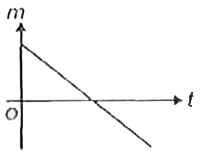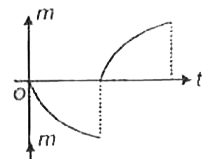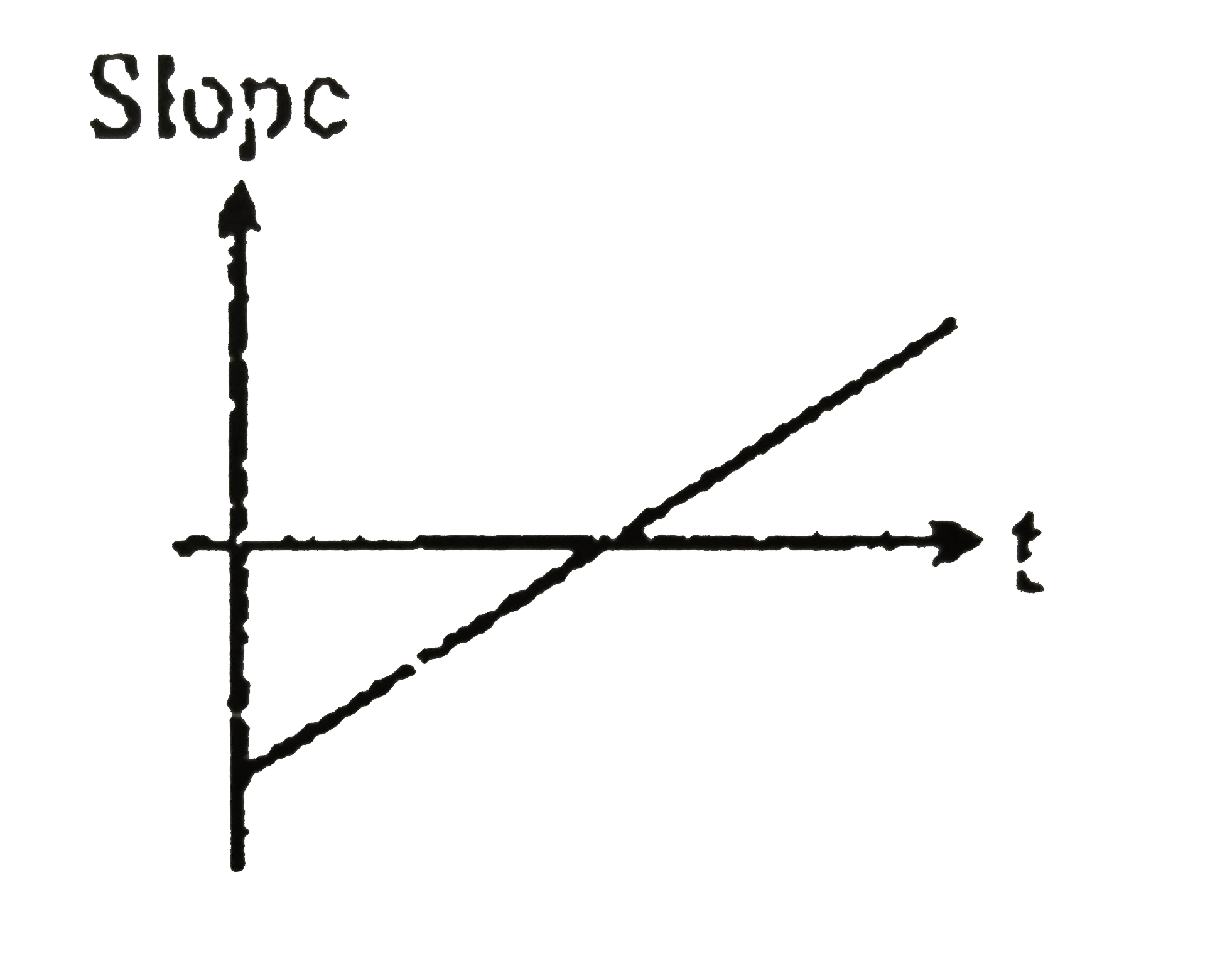A particle is dropped from a tower in a uniform gravitational field at t=0. The particle is blown over by a horizontal wind with constant velocity. The slope (m) of the trajectory of the particle with horizontal and its kinetic energy vary according to curves. Here, x is the horizontal displacement and h is the height of particle from ground at time t.
 .
.
 .
.
 .
.
 .
.
The correct Answer is:B, C
(b.,c.) Initially, accelerations are opposite to velocities. Hence, motion will be retarded. But after sometimes velocity will become zero and then velocity will in the direction of acceleration. Now the motion will be acceleration. As the particle is blown over by a wind with constant velocity along horizontal direction, the particle has a horizontal component of velocity. Let this component be v0. Then it may be assumed that the particle is projected horizontally from the top of the tower with velocity v0
Hence, for the particle, initial velocity u=v0 and angle of projection θ=0∘.
We know equation of trajectory is
y=xtanθ−gx22u2cos2θ
Here, y=−gx22v20 (puttingθ=0∘)
The slope of the trajectory of the particle is
dydx=−2gx2v20=−gv20x
Hence, the curve between slope and x will be a straight line passing through the origin and will have a negative slope. It means that option (b) is correct.
Since horizontal velocity of the particle remains constant, x=v0t.
We get dydx=−gtv0
So the graph between m and time t will have the same shape as the graph between mandx. Hence, option (a) is wrong.
The vertical component of velocity od the particle at time t is equal to gt. Hence, at time t,
KE=12m[(gt)2+(v0)2]
It means, the graph between KE and time t should be a parabola having value 12mv20att=0. Therefore, option ( c) uis correct.
As the particle falls, its height decreases and kE increases.
KE=12mv20+mg(H−h), where H is the initial height.
The KE increases linearly with height of its fall or the graph between KE and height of the particle will be a straight line having negative slope. Hence, option (d) is wrong.
Topper's Solved these Questions
- KINEMATICS-2BOOK - CENGAGE PHYSICSCHAPTER - KINEMATICS-2EXERCISE - Exercise Assertion - Reasoning
5 Videos
- KINEMATICS-2BOOK - CENGAGE PHYSICSCHAPTER - KINEMATICS-2EXERCISE - Exercise Comprehension
21 Videos
- KINEMATICS-2BOOK - CENGAGE PHYSICSCHAPTER - KINEMATICS-2EXERCISE - Exercise Single Correct
76 Videos
- KINEMATICS-1BOOK - CENGAGE PHYSICSCHAPTER - KINEMATICS-1EXERCISE - Integer
9 Videos
- KINETIC THEORY OF GASESBOOK - CENGAGE PHYSICSCHAPTER - KINETIC THEORY OF GASESEXERCISE - Compression
2 Videos
Similar Questions
A particle is projected at angle θ with horizontal from ground. The slop (m) of the trajectory of the particle varies with time (t) as
View SolutionA heavy particle is projected with a velocity at an angle with the horizontal into the uniform gravitational field. The slope of the trajectory of the particle varies as
View Solution
Knowledge Check
A particle is projected at angle θ with horizontal from ground. The slop (m) of the trajectory of the particle varies with time (t) as
A B
B C
C D
D
A heavy particle is projected with a velocity at an angle with the horizontal into the uniform gravitational field. The slope of the trajectory of the particle varies as
A B
B C
C D
D
A heavy particle is projected with a velocity at an acure angle with the horizontal into a uniform gravitational field. The slope of the trajectory of the particle varies as
A B
B C
C D
D
A particle (A) is dropped from a height and another particles (B) is thrown into horizontal direction with speed of 5m/s sec from the same height. The correct statement is
View SolutionA ball is thrown up with a certain velocity at angle θ to the horizontal. The kinetic energy varies with height h of the particle as:
View SolutionA particle is projected at an angle θ from the horizontal with kinetic energy (T). What is the kinetic energy of the particle at the highest point ?
View SolutionA particle (A) is dropped from a height and another particles (B) is thrown into horizontal direction with speed of 5m/s sec from the same height. The correct statement is
View SolutionA ball is thrown up with a certain velocity at angle θ to the horizontal. The kinetic energy varies with height h of the particle as:
View Solution
